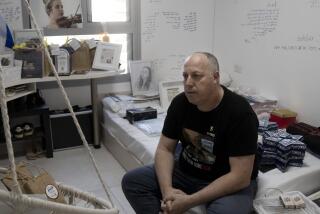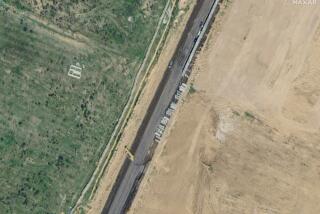Zahi Hawass: Come to Egypt — it’s safe and secure
Zahi Hawass, the best friend an ancient despot ever had, came to Southern California this week with a message for Americans who’ve been watching the land of the Pharaohs with amazement and concern: Post-revolutionary Egypt is safe, secure and tourist-friendly — so come on down!
The famously telegenic Egyptian antiquities minister rose to prominence during the autocratic reign of Hosni Mubarak and had rough going during and after the 18 days of people-power protests that led to Mubarak’s resignation four months ago, ending his 30 years of police-state rule.
But judging from his talk Wednesday at the Bowers Museum in Santa Ana, Hawass, 64, is back on top of his game when it comes to translating a king-sized ego, an adventurer’s charisma, a monumental enthusiasm for his country’s ancient past, an alternately puckish and blustery charm and a sense of comic timing into top-notch contemporary edutainment.
With more than 300 people packing the Bowers’ auditorium and at least as many more watching on screens set up in the museum’s indoor entrance court, Hawass and his slide presentation had them laughing, applauding, oohing and aahing. When it was over, a line almost as long as the Bowers is wide formed as audience members waited to get his signature on copies of his books on ancient finds.
Hawass devoted the first 10 minutes of his 80-minute presentation to an update on how antiquities fared during modern Egypt’s great lurch forward in January and February. Police abandoned their posts Jan. 28, and the Egyptian Museum, in Cairo’s Tahrir Square, the epicenter of the protests, was left unguarded. Looters broke in, and Hawass’ slides depicted some of the damage: a mummy’s head, separated from its body, was seen propped on white towels; an iconic statuette of Tutankhamen standing atop a black panther was shown broken in pieces; a glass display case had been smashed when a looter descending through a skylight fell into it, leaving bloodstains.
But at the end of the sequence, which included a shot of three captured looters looking shamefaced, the crowd was applauding: Tut and his panther were revealed to have been relocated, reunited and restored and were looking as good as new.
While 31 museum pieces remain missing, Hawass said, none is a “masterpiece.”
“Your monuments and our monuments are safe,” he assured the audience. “This is history. With freedom and democracy, Egypt can rise to the top.”
Earlier, in a phone interview as he rode to Orange County from Los Angeles, where he’d spoken Tuesday night at the Los Angeles County Museum of Art, Hawass said his tour is aimed at reassuring prospective American tourists that there’s nothing to fear in the new Egypt.
“The Egyptian government recognized that my face is the most recognized face outside of Egypt,” said Hawass. “I’m cooperating with the ministry of tourism to bring tourists back.” Indeed, his white hair, broad face and Indiana Jones-style broad-brimmed hat have been signatures of many a television special in which Hawass has deployed ultra-modern technology such as pyramid-probing robots and CAT scans of mummies in bids to unlock ancient secrets.
The stakes of his mission are high. The British magazine fDi Magazine recently reported that foreign visits to Egypt dropped 45% during the first quarter of 2011. Citing figures from tourism minister Mounir Fakhry Abdel-Nour, the publication said that $2 billion had evaporated from an economy that in 2010 had relied on tourism to generate $13 billion, representing 11.5% of Egypt’s gross domestic product and one-seventh of its jobs.
Hawass has had a tumultuous ride himself. Within a week of the initial protests in Tahrir Square, Mubarak shook up his government, and the restructuring elevated Hawass and his antiquities secretariat to a Cabinet-level position for the first time; previously, he had answered to the minister of culture.
But Hawass has always been a lightning rod for criticism as well as adulation. Some have found him high-handed in exercising his authority over the foreign archaeological teams that work in Egypt, and his spotlight-hogging is enough to chagrin purists who’d prefer a more subdued and scholarly approach. There was doubtless a current of schadenfreude in some archaeological circles when the news came in March that Hawass had resigned his new minister’s post — leaving, he says, to protest a failure by the Egyptian army and police to provide proper security at archaeological sites.
But Hawass has had the last laugh, at least for now: “My resignation made the government look at the sites, and they asked me to come back,” he said. “The field marshal [Mohamed Hussein Tantawi, who heads Egypt’s transitional military government] gave me complete support.”
Among the security improvements, he said, is the arming of antiquities guards — something he’d sought but had been refused in the Mubarak era. He said efforts are underway to recover 1,228 artifacts that were looted nationwide — none of them considered extremely significant.
Hawass said the true face of Egypt isn’t the looters who took advantage of a temporary security lapse but the young people who stepped in spontaneously to form a cordon around the Egyptian Museum on Jan. 28, preventing greater losses and damage.
“The people understand the meaning of antiquities,” he said.
As for Hawass, the upswing continues: In April, a Cairo misdemeanors court had sentenced him to a year in jail, the result of controversies reportedly stemming from a land dispute but which Hawass has said were really connected to a 2010 dispute over the contract to operate the Egyptian Museum’s bookstore. Hawass appealed, and he reported on his blog that a ruling Wednesday had cleared him of wrongdoing and removed the threat of jail.
“Today is a very special day for me,” he wrote. “The MSA [Ministry of State for Antiquities], and myself personally, have always held the laws of Egypt … in the highest regard and we will continue to do so.”
More to Read
The biggest entertainment stories
Get our big stories about Hollywood, film, television, music, arts, culture and more right in your inbox as soon as they publish.
You may occasionally receive promotional content from the Los Angeles Times.







